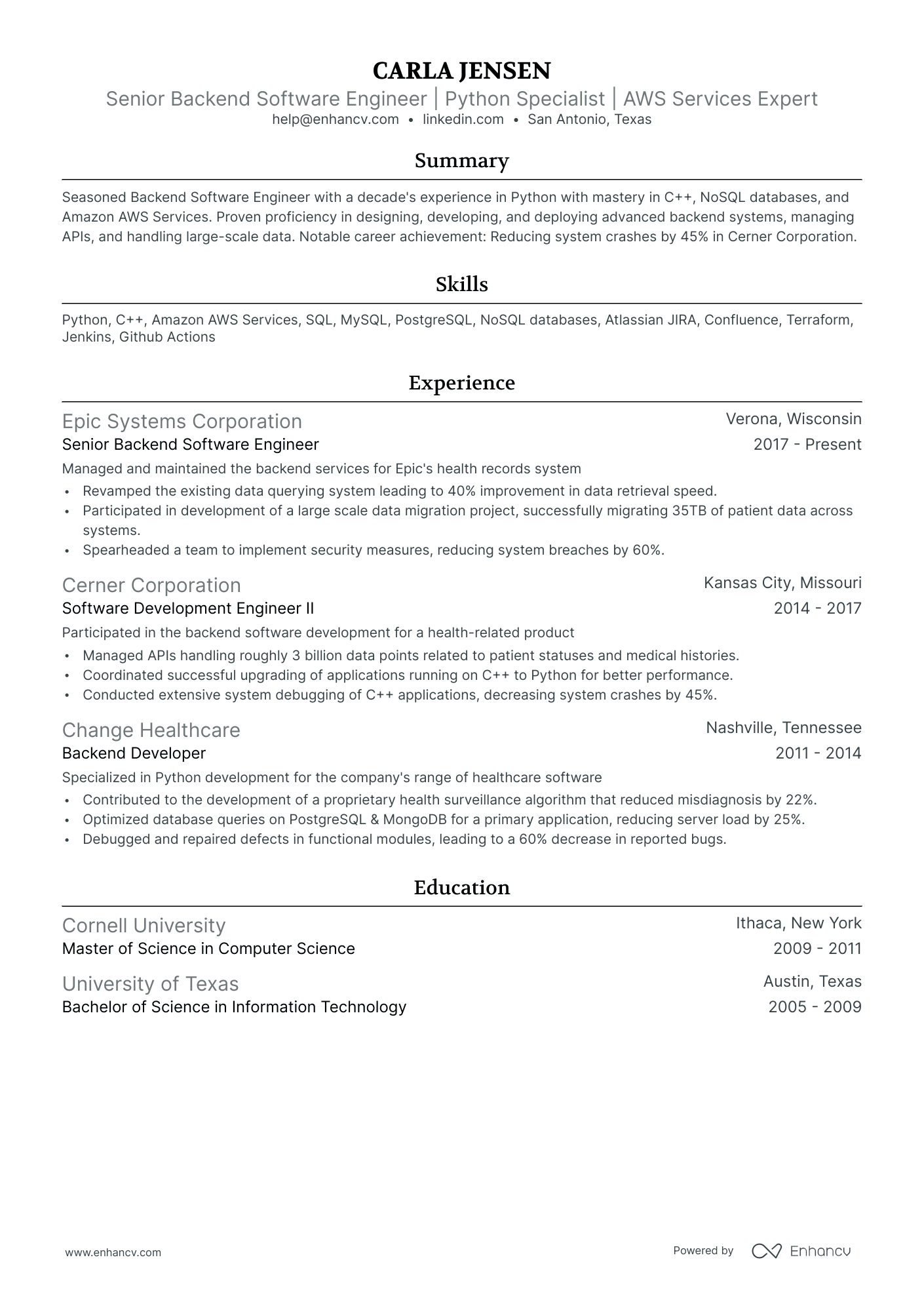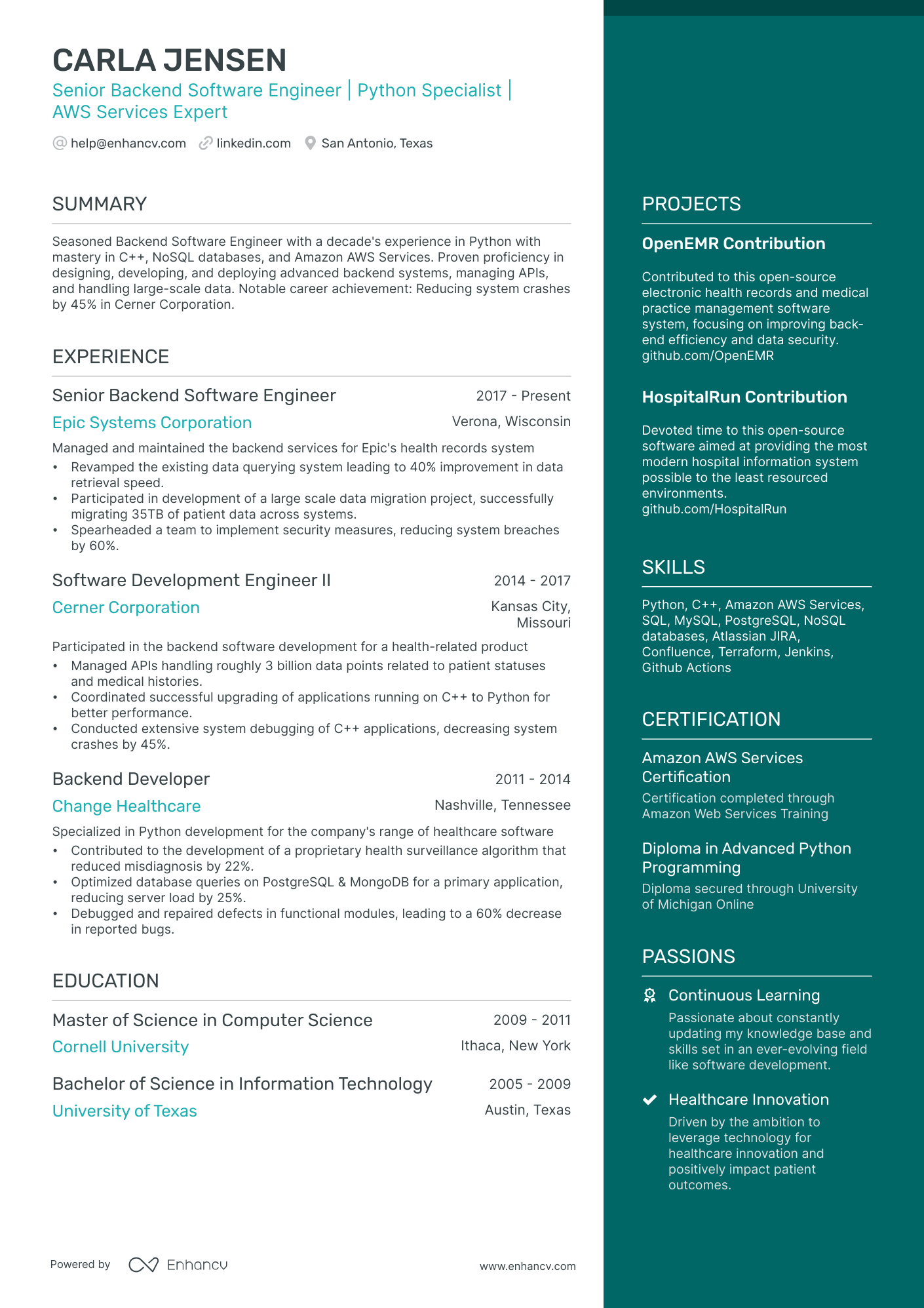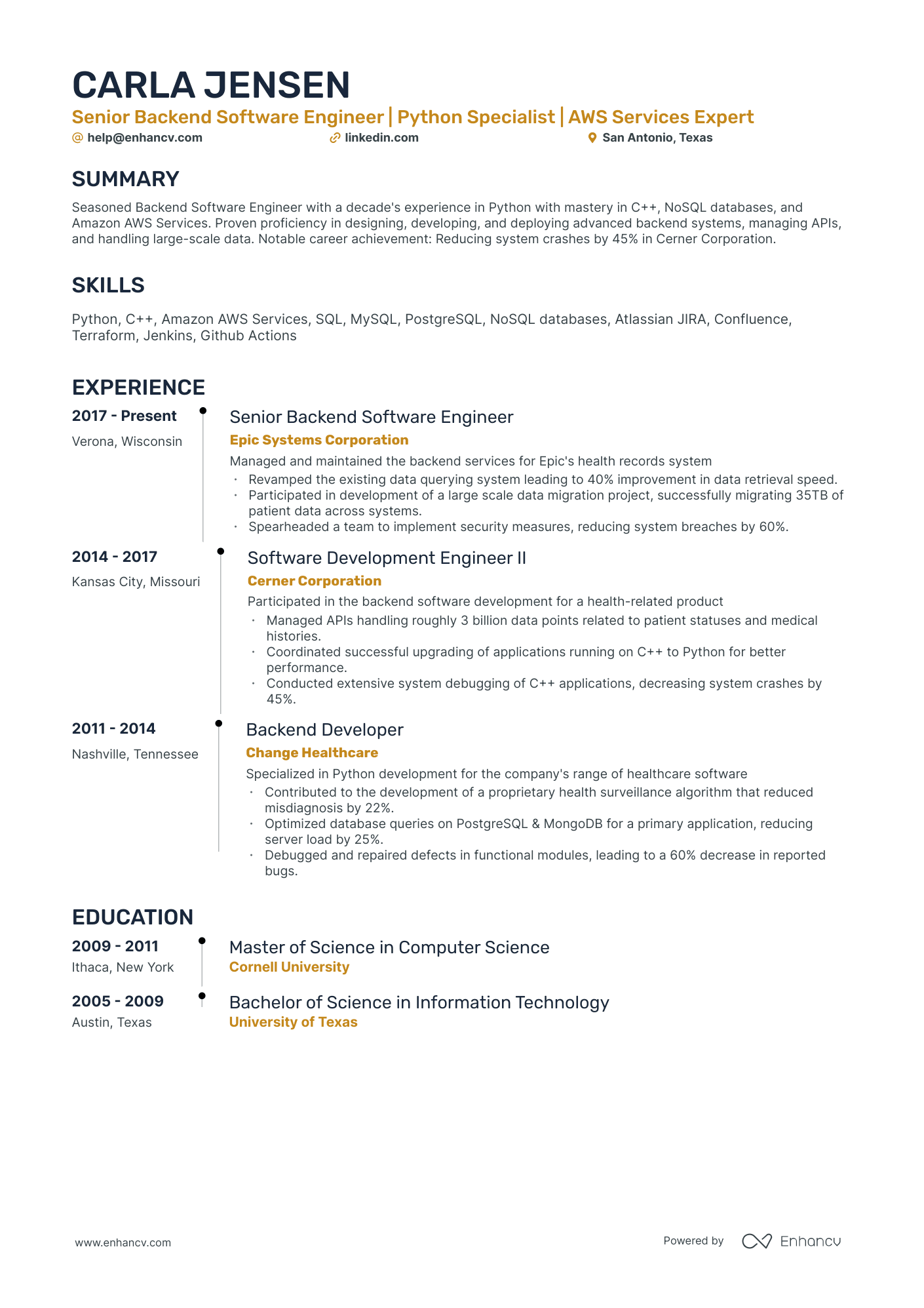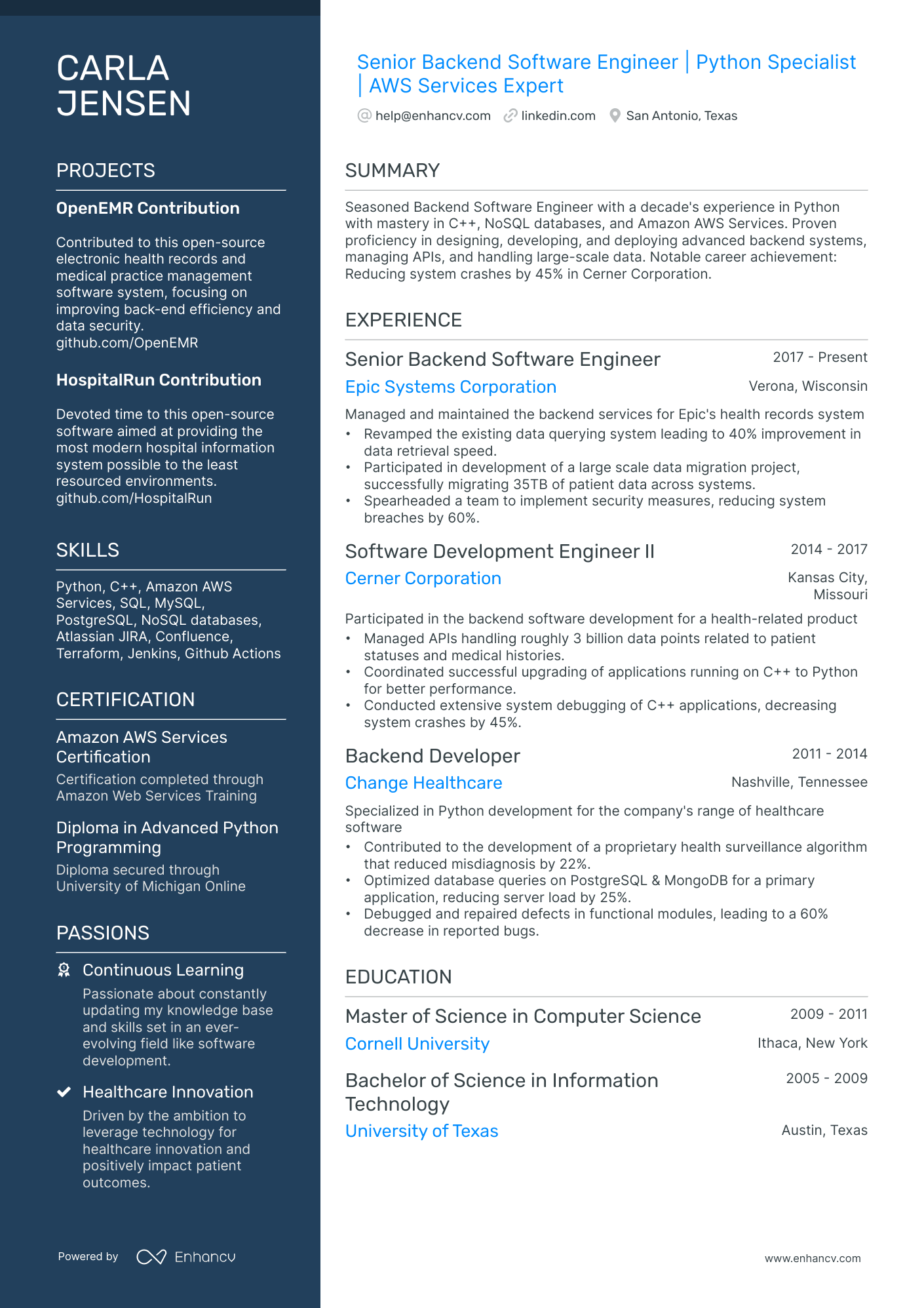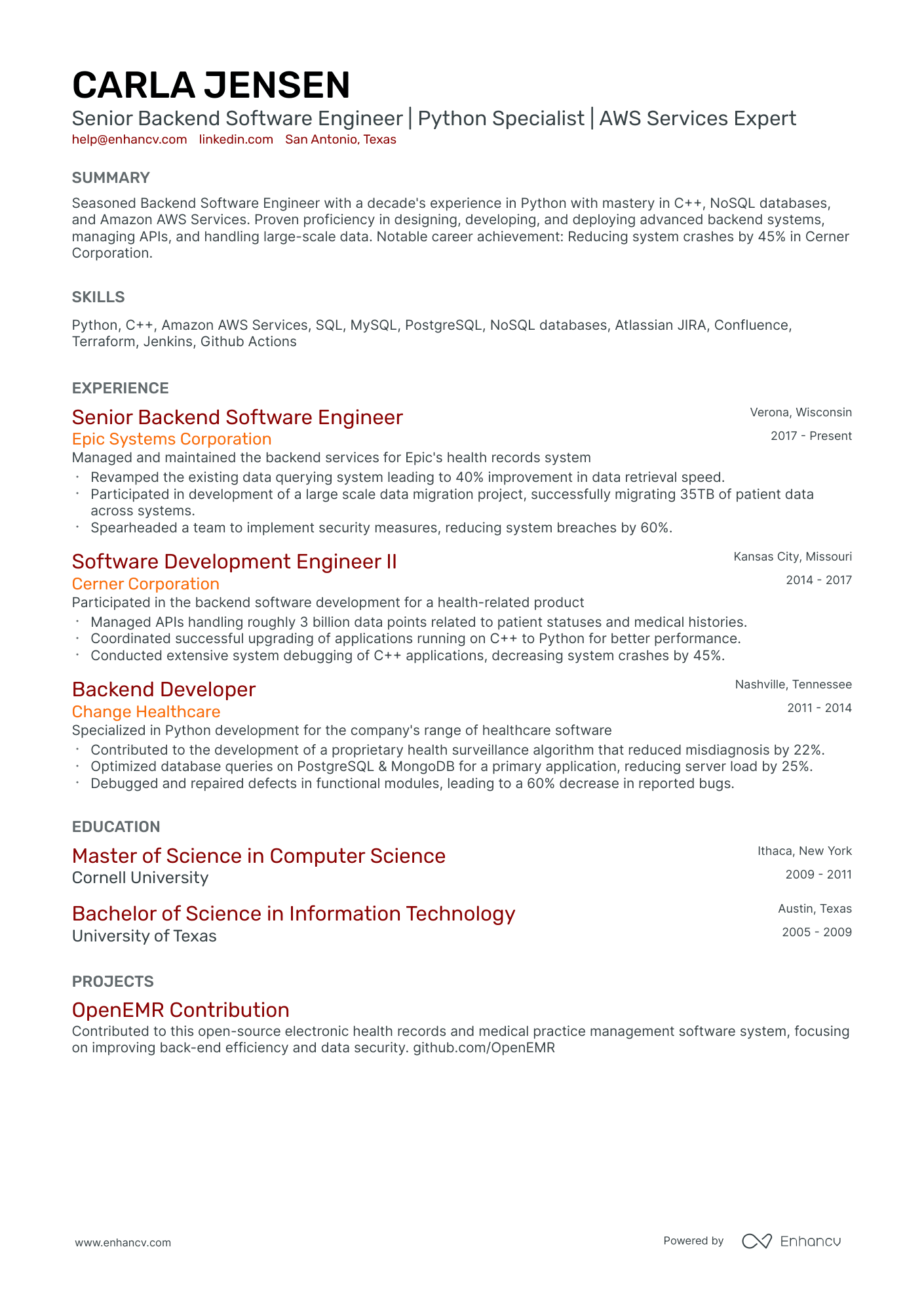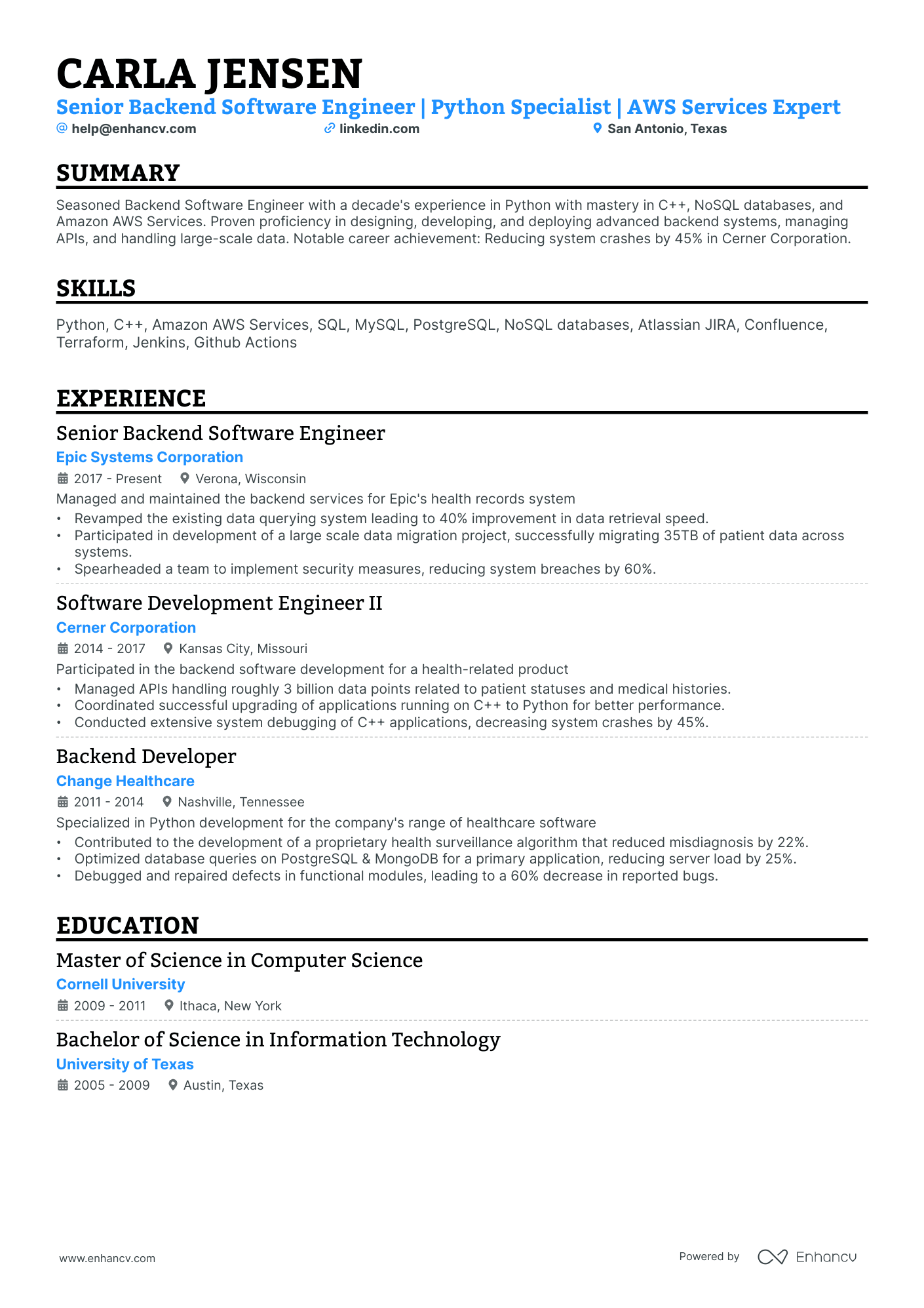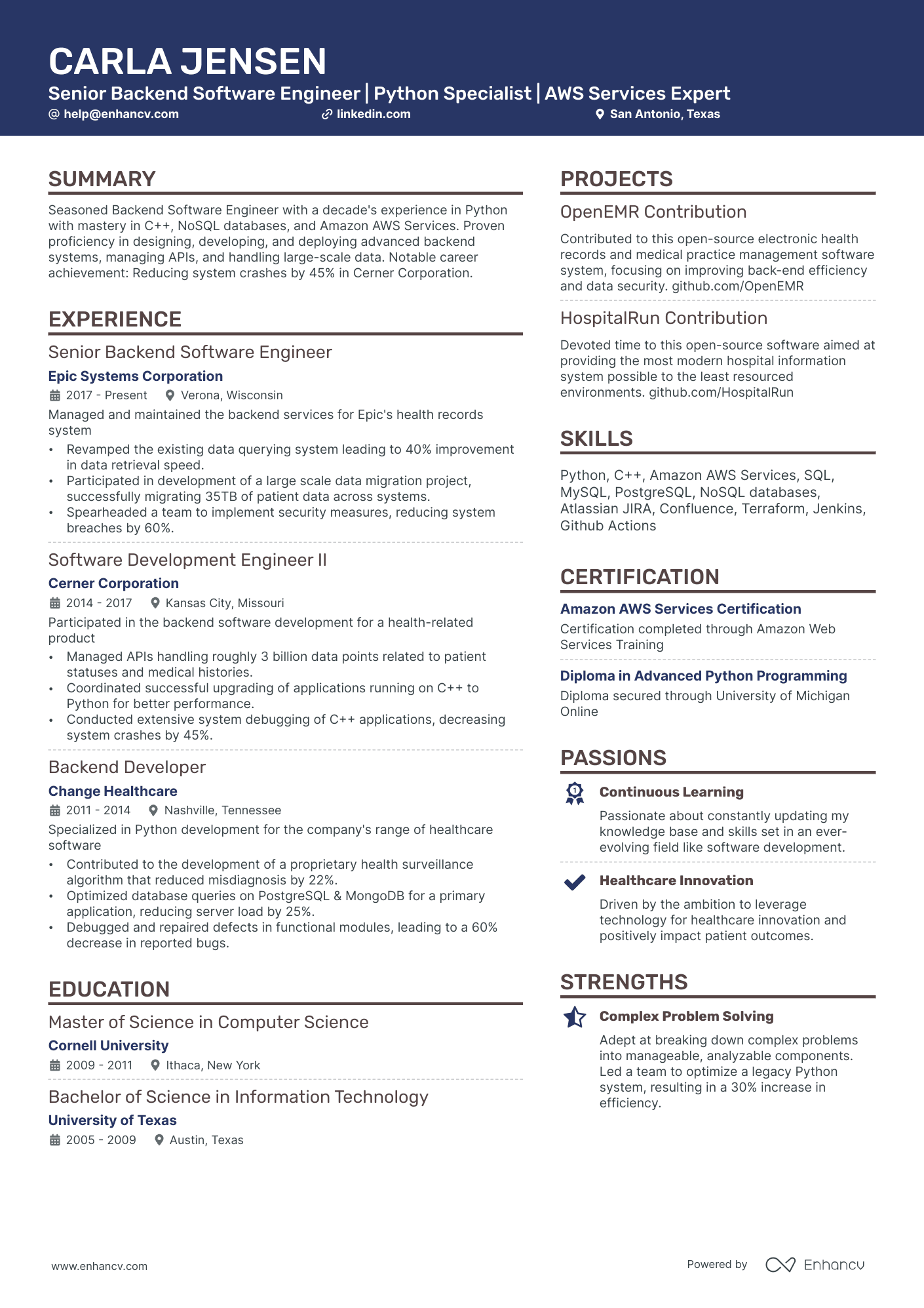Application security engineers often struggle to effectively convey their technical skills and experiences in a way that's understandable to non-technical hiring managers. Our guide can assist by providing strategies to articulate complex cybersecurity concepts and hands-on experiences in an easily digestible format, making it accessible to a wider range of audiences.
Dive into our concise guide to learn how to:
- Show your application security engineer career's brightest moments through your resume's summary, objective, and experience sections.
- Explore top-notch application security engineer resume examples to understand how to distinguish yourself from other candidates.
- Identify the most sought-after application security engineer skills and certifications in the industry.
- Design a structured yet unique resume layout.
Recommended reads:
simple guide to your application security engineer resume format
Successful application security engineer resumes all have something in common - candidates invest in a simple resume layout . One that is easy to read, makes a good first impression, and is adapted to their professional experience.
There are three distinct resume formats , which help you focus on different aspects of your resume. Those are:
- A reverse-chronological resume format - puts your most recent experience in the spotlight
- A functional skill-based resume format that makes your transferrable skills the center of attention
- A hybrid resume format - it combines skills and experiences.
What's more, keep in mind that your resume usually goes through an ATS (Applicant Tracker System) (i.e. the software used by companies in the hiring process).
The application security engineer resumes that suit the ATS:
- incorporate exact match keywords and skills from the job description;
- should be no longer than two pages;
- should be submitted in a PDF format, unless specified otherwise.
Consider your target market – resumes in Canada, for example, follow different layout conventions.
Upload your resume
Drop your resume here or choose a file. PDF & DOCX only. Max 2MB file size.
Pro tip
Consider incorporating design elements like icons or charts to enhance your resume's visual appeal and readability. But remember, the key is subtlety; don't let design overshadow content.
Don't forget to include these six sections on your application security engineer resume:
- A header for your contact details and a summary that highlight your alignment with the application security engineer job you're applying for
- An experience section that explains how you apply your technical and personal skills to deliver successful results
- A skills section that further highlights how your profile matches the job requirements
- An education section that provides your academic background
- An achievements' section that mentions any career highlights that may be impressive, or that you might have missed so far in other resume sections
What recruiters want to see on your resume:
- Experience with Application Security Tools: Demonstrate experience with application security tools such as OWASP Zap, Nessus, AppScan, or Fortify.
- Knowledge of Secure Coding Practices: Showcase knowledge and experience in secure coding practices and the ability to review and correct code for vulnerabilities.
- Certifications: Stand-out applications often include certifications like Certified Ethical Hacker (CEH), Offensive Security Certified Professional (OSCP), or Certified Information Systems Security Professional (CISSP).
- Understanding of Regulatory Compliance: Understanding of regulations that impact application security such as GDPR, CCPA, HIPAA etc., can be a big advantage.
- Cloud Security Expertise: As many applications are now cloud-based, having experience with cloud security on platforms such as AWS, Azure, or Google Cloud can be attractive to recruiters.
Recommended reads:
Detailing your relevant experience on your application security engineer resume
Showcase your credibility in the resume experience section. For an effective application security engineer resume:
- Highlight measurable achievements.
- Scan the job advert for keywords and integrate them throughout your experience section.
- Emphasize your technical proficiencies and how you've applied them in various roles.
- Keep it simple: mention your responsibility, relevant skills, and the outcomes.
- Use this section to convey your unique value, soft skills, feedback received, and the type of company culture you thrive in.
Top professionals ensure their experience section offers a captivating look at their expertise. Check out our sample application security engineer resumes for guidance.
- Conducted application security assessments and vulnerability scans, identifying and documenting critical issues.
- Collaborated with development teams to implement secure coding practices resulting in a 30% reduction in high-risk vulnerabilities.
- Developed and delivered training sessions on secure coding best practices, raising awareness among developers.
- Performed penetration testing and code review for web applications, uncovering critical vulnerabilities and providing remediation recommendations.
- Contributed to the development of an automated security testing framework, improving efficiency by 40%.
- Collaborated with cross-functional teams to prioritize and address security findings, ensuring timely resolution.
- Led security testing efforts for mobile applications across iOS and Android platforms, identifying and mitigating security risks.
- Implemented secure SDLC processes, resulting in a 50% reduction in vulnerabilities during the development lifecycle.
- Coordinated red team exercises to simulate real-world attacks and improve incident response capabilities.
- Conducted threat modeling and risk assessments to identify potential security weaknesses in large-scale enterprise applications.
- Developed and implemented security controls, resulting in a 25% decrease in successful attacks.
- Collaborated with development teams to perform secure code reviews and provide actionable recommendations.
- Researched and evaluated emerging security technologies, recommending their adoption to enhance application security posture.
- Performed security architecture reviews, ensuring compliance with industry standards and best practices.
- Assisted incident response teams in investigating and mitigating security breaches, minimizing impact on business operations.
- Conducted threat modeling and risk assessments for cloud-based applications, identifying vulnerabilities and providing mitigation strategies.
- Implemented security automation solutions, reducing the time required for vulnerability detection by 60%.
- Participated in security incident response activities, analyzing and containing security incidents to minimize impact.
- Led a team of application security engineers, overseeing security assessments and ensuring timely delivery of results.
- Developed and implemented secure coding guidelines and standards, significantly improving the overall application security posture.
- Collaborated with stakeholders to integrate security into the software development lifecycle, reducing vulnerabilities at early stages.
- Performed source code analysis and manual testing to identify security vulnerabilities in web applications.
- Conducted security training sessions for development teams, improving their understanding of secure coding practices.
- Collaborated with clients to define and implement application security strategies tailored to their specific needs.
- Led the design and implementation of a threat modeling framework to proactively identify security risks in software products.
- Collaborated with cross-functional teams to establish secure CI/CD pipelines, ensuring security checks at each stage.
- Participated in incident response activities, investigating security breaches and implementing measures to prevent recurrence.
- Performed manual penetration testing on network infrastructure, identifying vulnerabilities and providing recommendations for remediation.
- Developed custom scripts and tools to automate security testing processes, increasing efficiency by 50%.
- Assisted in the development of security policies and procedures, ensuring compliance with industry regulations.
Quantifying impact on your resume
<ul> <li>Detail the number of security risk assessments conducted, which showcases your ability to identify and mitigate potential threats.</li> <li>Mention the quantity of security protocols you have implemented or improved, indicating your proactive role in enhancing application security.</li> <li>Include the percentage reduction in security incidents post your interventions, demonstrating the effectiveness of your work.</li> <li>List the number of team members you've trained on security practices, giving evidence of your leadership skills and commitment to promoting security awareness.</li> <li>State the number of security audits successfully passed, proving your competence in maintaining compliance with security standards.</li> <li>Highlight the amount of security vulnerabilities detected and resolved, illustrating your proficiency in securing applications from potential threats.</li> <li>Note the number of complex projects managed, underlining your ability to handle high-responsibility tasks in a demanding environment.</li> <li>Indicate the size of the infrastructure (number of servers, networks) you were responsible for, showing your capacity to handle scale in security operations.</li>
Addressing a lack of relevant application security engineer experience
Even if you lack direct application security engineer experience, you can still craft a compelling resume. Here's how:
- Highlight projects or publications that demonstrate your relevant skills or knowledge.
- Emphasize transferable skills, showcasing your adaptability and eagerness to learn.
- In your objective, outline your career aspirations and how they align with the company's goals.
- Consider a functional or hybrid resume format, focusing on skills over chronological experience.
Recommended reads:
Pro tip
Remember, the experience section isn't just about traditional roles. It's a space to highlight all professional learning, whether from internships, contract roles, research projects, or other relevant experiences. If it's added value to your skill set for the application security engineer role, it deserves a mention.
Highlighting essential hard and soft skills for your application security engineer resume
Your skill set is a cornerstone of your application security engineer resume.
Recruiters keenly evaluate:
- Your hard skills, gauging your proficiency with specific tools and technologies.
- Your soft skills, assessing your interpersonal abilities and adaptability.
A well-rounded candidate showcases a harmonious blend of both hard and soft skills, especially in a dedicated skills section.
When crafting your application security engineer skills section:
- List up to six skills that resonate with the job requirements and highlight your expertise.
- Feature a soft skill that encapsulates your professional persona, drawing from past feedback or personal reflections.
- Consider organizing your skills into distinct categories, such as "Technical Skills" or "Soft Skills."
- If you possess pivotal industry certifications, spotlight them within this section.
Crafting a comprehensive skills section can be daunting. To assist, we've curated lists of both hard and soft skills to streamline your resume-building process.
Top skills for your application security engineer resume:
Static Application Security Testing (SAST)
Dynamic Application Security Testing (DAST)
Web Application Firewalls (WAF)
Threat Modeling
Secure Coding Practices
Penetration Testing
Security Information and Event Management (SIEM)
Container Security
DevSecOps
Application Security Frameworks (e.g., OWASP)
Problem Solving
Attention to Detail
Communication
Team Collaboration
Analytical Thinking
Adaptability
Time Management
Critical Thinking
Leadership
Empathy
Pro tip
Consider dedicating a separate skills section on your application security engineer resume to showcase your technical proficiencies, especially if you want to highlight specific software expertise.
Choosing the right certifications and education for your application security engineer resume
Your education section can highlight skills and experiences perfect for the job.
- List college or university degrees with the school name and dates.
- If you're still studying, mention your expected graduation date.
- Think twice before adding unrelated degrees. Space on your resume is precious.
- Discuss educational achievements if they boost your job relevance.
There are many certifications out there. Which ones should you include?
- List your main degree in a separate section with the school name and dates.
- Only add certifications that highlight your skills and experience.
- Place unique or recent certifications near the top.
- Add a brief description to certifications if it helps show your skills.
Remember, it's not about quantity but relevance.
Best certifications to list on your resume
- Certified Information Systems Security Professional (CISSP) - ISC²
- Certified Information Systems Auditor (CISA) - ISACA
- Certified Information Security Manager (CISM) - ISACA
- Offensive Security Certified Professional (OSCP) - Offensive Security
- Certified Cloud Security Professional (CCSP) - ISC²
- Certified in Risk and Information Systems Control (CRISC) - ISACA
- CompTIA Security+ - CompTIA
Pro tip
If you have plenty of certifications, prioritize the most relevant and industry-recognized ones. Arrange them based on their relevance to the job at hand.
Recommended reads:
Summary or objective: maximizing the impact of the top third of your resume
The top third of your application security engineer resume is crucial. It's often the first thing recruiters see and can set the tone for the rest of your application.
Whether you choose a resume summary or a resume objective, make it count. The former is great for showcasing career highlights, while the latter balances your achievements with your future aspirations.
Both should be tailored to the role, as there's no universal approach to crafting the perfect application security engineer summary or objective. Use the examples below as a starting point.
Resume summary and objective examples for a application security engineer resume
Optimize your resume summary and objective for ATS
Drop your resume here or choose a file.
PDF & DOCX only. Max 2MB file size.
How to include other relevant sections for your application security engineer resume
Apart from the standard sections listed in this guide, you have the opportunity to get creative when building your profile.
Select additional resume sections that you deem align with the role, the department, or the company culture.
Here are the ones we recommend:
- Language skills - use a profficiency framework to indicate your aptitude level;
- Hobbies and interests - you can share more about your favorite books or how you spend your time. It's great for culture alignment;
- Volunteering - helps you highlight the causes you care about and hints at people skills you gained such as teamwork, emotional intelligence, and organizational skills;
- Awards - the space for your most prominent application security engineer professional accolades and achievements.
Make sure that these sections don't take too much away from your experience, but instead build up your application security engineer professional profile. You can add them as a second column to your resume, or on a second page.
Key takeaways
- A clear resume layout helps present your info well.
- Use all main resume sections to show how you fit the job.
- Detail specific skills or tasks and their impact.
- Show your personality through interests or hobbies.
- List certifications to back up your technical skills.
